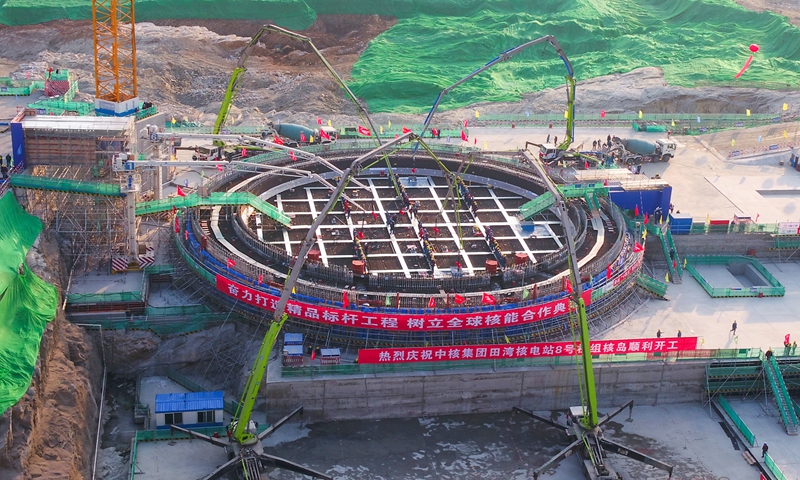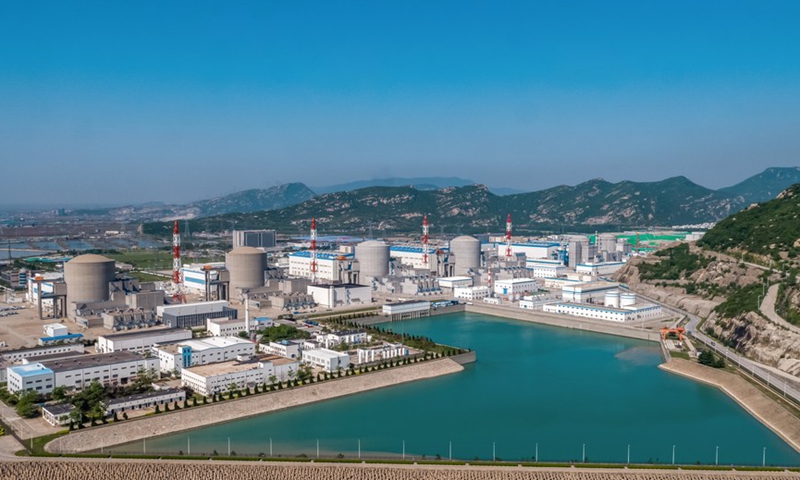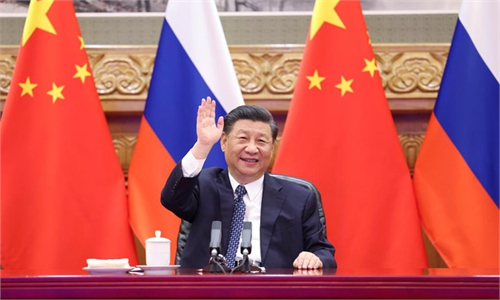
The first tank of concrete is poured at the construction site of the nuclear island reactor of Unit 8 of the Tianwan Nuclear Power Plant in Lianyungang, East China's Jiangsu Province, on February 25, 2022. Photo: VCG
Construction of the No.8 unit of the Tianwan Nuclear Power Plant has begun in Lianyungang, East China's Jiangsu Province. It is the first domestic nuclear power unit that started construction in 2022. The No.8 unit is the last reactor of China and Russia's largest nuclear power cooperative project.
Tianwan's No.8 unit is scheduled to be put into operation in 2027, China National Nuclear Corporation (CNNC) said on Monday.
According to CNNC plan, Tianwan nuclear power plant is designed to have 8 million-kilowatt pressurized water reactor (PWR) generating units, with a total capacity of 9 million kilowatts, which are able to generate 70 billion kilowatt-hours of clean electricity annually.
Once the No.8 unit is put into operation, Tianwan Nuclear Power Plant will become the world's largest nuclear power base.
Tianwan Nuclear Power Plant is the largest China-Russia nuclear power cooperation project. The first four units use Russia's VVER-1000 model. Unit No.7 and No.8 use Russia's third-generation VVER-1200 model, with a single unit capacity of 1.265 million kilowatts. The No. 5 and No. 6 units adopted China's independent M310+ PWR nuclear technology of CNNC.
The completed six units of the plant have generated 48.219 billion kilowatt-hours of electricity in 2021, setting a new record. More than 300 billion kilowatt-hours of electricity will be generated over the lifetime of the six units in total, said CNNC, which holds a 50 percent share in the Tianwan Nuclear Plant.
The No.7 and No.8 units will generate 18.8 billion kilowatt hours of electricity annually once put in use, equivalent to reducing carbon dioxide emissions by 15.34 million tons a year.

Aerial photo taken on May 17, 2021 shows an overview of the Tianwan nuclear power plant in Lianyungang City, east China's Jiangsu Province. Photo:Xinhua
China and Russia have ratcheted up cooperation in the field of energy, including nuclear energy, such as Tianwan Nuclear Power plant and Xudapu Nuclear Plant in Huludao, Northeast China's Liaoning Province.
According to the statistics published by the General Administration of Customs, China imported 334.29 billion yuan ($53.4 billion) of energy products from Russia in 2021, up 47.4 percent year-on-year, accounting for 65 percent of the total imports from Russia.
China is committed to developing clean nuclear power. According to the outline of China's 14th Five-Year Plan (2021-25), 70 million kilowatts of nuclear power will be installed by 2025. By 2030, the installed capacity of nuclear power in operation will reach 120 million kilowatts, and power generated by nuclear generators will account for 8 percent of China's total electricity generation.
In 2021, China generated 371 billion kilowatt-hours of nuclear electricity, up 1.3 percent year-on-year, according to the National Energy Administration.
By January 1, 2022, China has 53 nuclear power units connected to the power grid, with a total installed capacity of 546.695 million kilowatts, ranking third in the world.
Global Times



